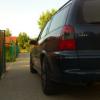-
Hozzászólások
5.510 -
Csatlakozott
-
Utolsó látogatás
-
Days Won
6
Content Type
PROFIL
Fórumok
MAGAZIN-CIKKEK
MÉDIA
KÉPTÁR
BLOG / NAPLÓ
NAPTÁR
Everything posted by Tápiószecső
-
Nem nagyon. A gyári megoldások elég jól szerepelnek, ha van megfelelő hideg levegő bevezetése, és az esetleges fojtások eltávolításra kerülnek. (ez utóbbi elég típusspecifikus dolog)
-
Nekem szó szerint ugyanez a jelenség volt, de központi befecskendezésnél. Ott már gyújtáson telenyomta benzinnel az egészet, amikor a pupma elkezdett működni. Az egyik O gyűrűn volt egy nagyon pici szakadás, ami nem tudta már tartani a nyomást. Én továbbra is azt mondom, ha ennyire rendellenesen sok anyagot kap, akkor az csak valami nem szabályzott (vagy szabályzás alól kikerült) alkatrész hibája lehet. C20XE egyébként nem volt B Vectrában gyárilag szerelve, így ezzel a motorral itt a topikban valószínűleg nem sokan járatosak.
-
Akkor kábelköteg. :unsure: Próbáld kiszerelve működtetni az injektorokat. (csak vigyázz, mert tűzveszélyes)
-
Ha szó szerint áll a benzin a motorban, akkor az injektorral lesz gond. Mind a 4 hengerben ugyanez a jelenség?
-
Az tényleg fura. Meddig volt lehúzva? Próbáld anélkül indítani, és úgy használni egy darabig. Minden lehet. Meg az ellenkezője is. :) Ha annyira gyanús, akkor szerezz egy cseredarabot bontóból. És ha már ott vagy cserélj egy vízhőmérséklet jeladót is. Hátha. Gyertyák mikor voltak cserélve? Gyáriak?
-
Igaz, az ablakfűtésé tényleg más. ;)
- 5.482 válasz
-
Csak valami elkezdett remegni... :P Bocs. :)
-
A ház biztosan nem egyezik. Z22SE-n elöl van az önindító. De a házcsere valószínűleg megoldható.
-
Én itt próbálkoznék. ;)
- 1.206 válasz
-
Ki kell tisztítani mindent, amit lehet a szívórészen. Csöveket ellenőrizni nem repedtek vagy csúsztak le a helyükről. Vezetékeket/csatlakozásokat szintén ellenőrizni/tisztítani. (repedt szigetelés, oxidálódott csatlakozás)
-
Az a gomb ugyanolyan, mint a többi. Rakj át egy másikat és nézd meg azzal megy-e. Lehet hogy valamit rosszul forrasztottál abban a kapcsolóban, összeér valami vagy elengedett.
- 5.482 válasz
-
Több, mint 5 éves hozzászólásra reagáltál. Én nem láttam az illetőt errefelé mostanában. Érdemes lehet privát üzenetet írni neki, arról általában mindenki kap e-mail értesítést. ;)
-
A befecskendezett üzemanyag mennyiség egyik meghatározója. Ha rossz általában hibakódot ad. Értelemszerűen dús vagy szegény keveréket eredményezhet.
-
1. Valameddig biztos, de ha mondjuk csak a gumiharang van kirepedve azt nem érdemes halogatni, mert főleg ebben az időben elég sok koszt behordhat még. 2. Talán valamelyik jeladó (vízhőmérséklet, levegőhőmérséklet/légtömegmérő). 3. Ha megvan hol zörög, akkor én csak kiékelném. De ez a te döntésed. 4. Víz van benne vagy csak pára? Nem szokott sehol. Vagy repedés van rajta vagy valami illesztés engedett el esetleg az izzónál nem jó szigetelés. 5. Ha a visszajelző nem világít, akkor lehet hogy kiégett az égő. Ha gáz nincs benne, akkor nem kapcsol be, mert van benne nyomásérzékelő. Sokáig nem érdemes így hagyni, mert nem tesz jót a kompresszornak a sok állás. Nekem egyébként csak egészen halkan hallhatóan kapcsol be. Nem is mondanám igazi kattanásnak. ps: Ha nem illik az összes a témába, akkor írj több hozzászólást a megfelelő helyekre, hogy ne legyél offtopik. ;)
-
https://www.youtube.com/watch?v=_cPDwL9gW2I
-
Színes tv. Nem semmi. :D Kihangosító elég sok fejegységben van már, de kétlem hogy ezt teljeskörűen tudná valami utólagos kezelni. Nincs tippem a problémádra, én dobom a gyárit valamikor, de nekem csak a multikormány a fontos, arra pedig van megoldás. Jobb alul az mi?
-
Milyen computer vezérlés?
-
Ha a gombokból kiszeded a műanyag foglalatot, amibe az izzók vannak beforrasztva, akkor lesz elég hely. (Hamarosan nekem is lesz egy leírásom róla.)
- 5.482 válasz
-
Ahogy látom van 70, 100, és 120 is. http://www.partsbase.org/opel/vectra-b-1996-2002-16-1-engine-and-cooling/ Nézd meg hátha látsz valami jellegzetes különbséget a rajzon a különböző generátorok közt.
- 5.482 válasz
-
De a háza is? Nincsenek különböző kialakítások a különböző felfogatásokhoz?
-
Dieselben az 1-es is hosszú, neked is azt kellett volna venni. :P Csak hogy érzékeltessem a probléma lényegét 55-től elviszi az 5-öst kényelmesen, 110-nél forog 3000-et és 130nál már 3500 felett, mindezt egy viszonylag nagy nyomatékú jellemzően nem városi használatra tervezett autóban. Látsz ebben valami rációt? Én csak egyet tudok, lakott területen gyakorlatilag soha nem kell váltanom, de ezt a kényelmet szívesen feláldoznám.
-
Köszi, de nem vagyok benne biztos hogy a G Astra váltóház stimmel B Vekihez, és egyelőre csak ötletelek, amíg nem végleges a motor addig valószínűleg nem módosítok a váltón. (csak akkor raktam volna egy hosszú 5-öst, ha egyszerűen meg lehetett volna oldani) Egyébként az 5-öse nem sokkal hosszabb, amiatt csak 2,5km/h -t nyernék a mostanihoz 5-ben 3000-nél, a 3,632-es vég miatt viszont már nem olyan rossz (12km/h). A WR 5-öse viszont a 3.947-es véggel is 20 km/h-t hoz. (A 3,632-vel 30-at :))
-
Vagyis de. :) Összehozható egy ilyen, csak a tengelyeket is meg kell variálni: F23xR: 1:3,577 2:1,887 3:1,348 4:0,977 5:0,686 F23WR: 1:3,577 2:1,887 3:1,192 4:0,848 5:0,686 F23SR: 1:3,577 2:2,022 3:1,348 4:0,977 5:0,809 Ami fix, hogy az 1,2,5 és a 3,4 együtt maradnak.
-
Hiánypótló írást találtam F23-hoz: http://www.fiero.nl/forum/Forum1/HTML/087296-2.html Ez az eredeti, de itt csak linkelve vannak a képek: http://www.automotiveforums.com/t950851-getrag_f23_rebuild.html De a teljes topikban lehetnek érdekes infók: http://www.fiero.nl/forum/Forum1/HTML/087296.html És akkor már a hivatalos videó se maradjon ki. És ezzel nyilvánvalóvá vált, hogy nem tudok csak külön 5-öst cserélni: "5th drive gear are cast as part of the input shaft" :( És 4-est sem: "4th final driven are part of the output shaft" :cry: És bemásolom, mert ezek a jó írások mindig el szoktak tűnni idővel: "First we start with the input shaft. The order of major hard componants goes as such. Left to Right: 1st Drive Gear, 2nd Drive Gear, 5th Drive Gear, 3rd Drive Gear, 3-4 synchronizer Assm., 4th Drive Gear. http://img.photobucket.com/albums/v296/Xxway2fast4uxX/01%20cavalier/100_1165.jpg -Facts to remember are 1st, 2nd, and 5th drive gear are cast as part of the input shaft meaning they always turn with the shaft, 3rd and 4th drive gears only drive at the speed of the input shaft when the synchronizer sleeve (which is splined to the input shaft) is locked into either gear. Next we have the Countershaft. Top to bottom: Countershaft Final Drive, 2nd gear #1 driven, 2-1 synchronizer Assm., 1st gear #1 Driven http://img.photobucket.com/albums/v296/Xxway2fast4uxX/01%20cavalier/100_1166.jpg -Facts to remember are, the Countershaft final drive gear is part of the shaft, 1st and 2nd #1 driven gears are only splined to the shaft via the synchronizer being engaged to the gears. And lastly we have the output shaft. Left to Right: Final Drive, Rev final driven, R-5 synchronizer Assm., 5th Final Driven, 3rd Final Driven, 4th Final Driven http://img.photobucket.com/albums/v296/Xxway2fast4uxX/01%20cavalier/100_1163.jpg -Facts to remember are, the Big gear just to the right of the Final drive gear spins freely on the shaft along with the 5th gear final driven until either is selected with the synchronizer sleeve. 3rd final driven and 4th final driven are part of the output shaft and obviously are always engaged with it. 1st Gear: Begins with the first gear from the left on the input shaft. Power is transmitted to the 1st gear #1 driven gear on the countershaft (Big one on the bottom) when the shift fork engages the 1-2 synchronizer into the 1st gear position. The gear is locked to the countershaft and power is transmitted through the shaft to the countershaft final drive which meshes with the second to last gear from the left on the output shaft. From there it turns the final drive gear which of course, turns the differential. 2nd Gear: The shift fork on the countershaft moves back out of first gear position and into second. The second gear from the left on the input shaft drives the 2nd gear from the bottom on the countershaft which is now locked to the countershaft via the synchronizer. Again it drives the Countershaft Final drive gear which meshes with the second to last gear on the output shaft transmiting power through the output shaft to the final drive gear, into the diff. 3rd Gear: Much simpler then 1st, 2nd, or reverse. 3rd is engaged by sliding the 3-4 synchronizer sleeve toward the left locking 3rd drive gear to the input shaft, this transmits power to the second to the last gear on the output shaft which again, is part of the output shaft, turning the differential. 4th Gear: Similar to 3rd the synchronizer sleeve is slid to the right engaging 4th drive gear and locking it to the input shaft. That gear drives the gear furthest to the right on the output shaft which is also part of the output shaft, Driving the output shaft and the differential. 5th Gear: 5th Gear is simple like 3rd and 4th however instead of locking the DRIVE gears to the input shaft they are ALWAYS part of the input shaft which means we have to Lock the DRIVEN gears to the output shaft. In this case the biggest gear (3rd in from left) on the input shaft is the drive gear, again note it is part of the shaft. Its mating member on the output shaft rotates freely until we slide the 5-R synchro towards the right. This locks the 5th Driven gear to the output shaft which turns the Final drive gear. Reverse: Reverse is unique in this transmission since it uses 1st gear componants. The power flow moves from the first gear on the left of the input shaft, through the largest gear on the countershaft (which spins freely on the countershaft since the synchronizer is not engaged and it rides on the shaft with a roller bearing) This big gear then drives the Large gear 2nd in from left on the output shaft, but since there is an extra step in the gear train the output rotation is reversed. A good way to look at this is that an odd number of meshing gearsets will allow both input and output shafts to rotate the same direction, an even number of gearsets will allow the input and output shafts to rotate in opposite directions. One install set of pics. (http://s268.photobucket.com/albums/jj19/italianscorpio75/LSD%20install/?albumview=slideshow) My pics.. http://photos.imageevent.com/intimidator/jbody/P1010096_3.JPG another pic of the fork and gear http://photos.imageevent.com/intimidator/jbody/P1010099_1.JPG all three shafts out and on the bench http://photos.imageevent.com/intimidator/jbody/P1010109_1.JPG all installed about to seal up and reinstall trans back in car http://photos.imageevent.com/intimidator/jbody/P1010113_2.JPG Make sure you use an anaerobic sealer between the housing or you'll get a fluid leak."
-
A difi eltolja az egészet, és bár az arányok megmaradnak lehet, hogy pont nem lesz jól használható, egy 5-ös csere viszont nem bántja a többit. (legfeljebb a 4-est kell kcsit tovább húzni és az 5-öst nem használhatod olyan alacsony sebességgel, mint eddig.) Ráadásul a linkelt 7.07-es vagy 0.744-es 5-össel jóval többet nyerhetsz, mint a 3.45-ös véggel. (ez utóbbi alig változtat valamit.) Az 5-ös cserék sok esetben a váltó kiszedése nélkül is elvégezhetők, de nem tudom az f20 ilyen-e. Azt sem tudom, hogy az f18 fogaskerekek rámennek-e egyáltalán az f20 tengelyre. Akárhogyis nem lesz túlzottan egyszerű. Csak fogaskerékpárokat szinte senki nem árul. A teljes bontott váltó beszerzése pedig feleslegesen drága. És lehet, hogy a maradékkal nem is tudsz mit kezdeni. Én is ebben a cipőben járok. :( Zaj vagy fogyasztás miatt zavar a magas fordulat? Minimálisan segíthet egy kicsivel nagyobb átmérőjű kerék.



